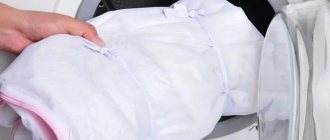Is it possible to wash a duvet?
Bedding made from natural materials ensures a comfortable sleep for the whole family. The duvet has good breathability, it is airy and light, but at the same time strong and durable.
Duvet covers and pillowcases are very easy to wash, but the filling inside a warm blanket or pillow accumulates moisture and sweat over time. This causes the emergence of dangerous fungi or dust mites, which means exacerbation of allergic reactions in children or adults. This item is in dire need of washing.
There is no need to spend a lot of money going to dry cleaning. The duvet can be washed at home in a machine or by hand. You should not repeat the procedure too often; it is enough to perform such bedding care once a year.
Duvet with swan down filling
Attention! Industrial production excludes the use of natural swan down, since it cannot be obtained without harm to the bird.
Manufacturers use synthetic filler that replicates all the properties of real down. The cover is made of natural cotton or other types of fabric.
If a small stain has formed on the cover of the product, it is not necessary to wash the entire duvet. You can try to clean the stained area with a dampened sponge or a special stain remover pencil.
Preparing bedding for washing
Before washing such a product, you need to properly prepare it. This process includes the following manipulations:
- Remove the duvet cover. It must be washed separately according to the manufacturer's recommendations on the label.
- Estimate the size and weight of the blanket. There must be enough space in the washing machine drum during washing. For this reason, it is recommended to use dry cleaning services to clean bedding that is too large or heavy.
- Examine the contents of the tag attached to the blanket. This will help you understand in what mode and at what temperature it is recommended to wash the product, as well as how to wring it out and dry it. Thus, the numbers on the symbol indicate the washing temperature, and the circle enclosed in a square indicates that the items can be machine dried. Most manufacturers provide information regarding product care in text format, which is much more convenient for the consumer.
- Carefully inspect the blanket and, if there are even small holes or loose seams on its surface, sew them up. This measure will prevent fluff from falling out during washing and drying.
- If there are heavily soiled areas, soak the product. This should be done in a large container, such as a bathtub, filled with warm, soapy water. The average soaking time is 1 hour. To facilitate the process of removing contaminants from the material, you can add a small amount of vinegar to the water.
What mode should you use to wash a duvet?
To ensure that washing a swan down blanket does not end badly for the product, the housewife should select the “delicate” mode. Some machines have a “bulk items” function; this mode is also suitable for caring for bedding, blankets or jackets.
LG washing machines have a “duvet” mode, which sets the temperature to 40 degrees and no more than 800 spin speeds, washing time is approximately 1 hour.
Advice! You can wash a down item less often if you dry it in the open air once a month and shake it, thoroughly knocking out the dust.
It is worth choosing the most suitable mode for washing based on the brand of washing machine
Tips and tricks
To ensure that washing a duvet does not lead to disastrous consequences, you need to take into account the following recommendations:
- Do not load the washing machine more than 2/3 full. If the blanket is difficult to fit into the drum, it is better to avoid washing it yourself.
- Once a month, the blanket should be taken out into the fresh air to dry. In summer, choose any dry, windy day, and in winter, frosty, sunny weather is suitable.
- Light and white duvets can be washed using products containing oxygen bleach.
- The conditioner used during washing makes the fabric of the cover softer and gives the product a pleasant aroma.
- When washing by hand, you can replace the liquid detergent with regular hair shampoo.
Useful tips and tricks for washing blankets can be found in this section.
How to wash a duvet at home
Some bedding cannot be washed at all, dry wash only. As a rule, these are products made of silk, some types of wool and other delicate fabrics. If the duvet consists of a synthetic filler and a natural textile cover, it can be washed by hand or in a machine.
How to wash a duvet in a washing machine
It is worth considering simple rules:
- The first step is to check if there is any damage to the fabric cover. Small holes or unraveling seams will cause loss of filler, as a result of which not only an expensive item will be damaged, but the washing machine will also suffer - fluff will clog up in the filters.
- Do not use bleach or regular powders to wash delicate items. Such substances will not completely dissolve when rinsing; the fluff under the cover will collect in clumps. You should purchase liquid laundry detergents, as well as a special conditioner for delicate fabrics.
- It is best to fold the duvet in several layers and in this state put it in the drum of the washing machine so that lumps do not collect inside the product. Ordinary shady balls will help prevent the filler from clumping in a horizontal-loading washing machine. They need to be placed together with the item, the balls will knock out the dirt and break up the clumps of fluff.
- Be sure to duplicate the rinsing process and, if necessary, spin the item twice at 800 rpm.
- Upon completion of washing, the product is immediately removed from the drum and the drying phase begins.
Attention! If the bulky bedding hardly fits into the drum, the door barely closes and there is no free space for water, you will have to abandon machine washing.
Need to fold a bulky item for machine washing
How to wash a duvet by hand
Bulky double blankets are difficult to fit into the drum of a standard machine with a capacity of 5-6 kg. Such items will have to be washed by hand. But it is almost impossible to do this alone; it is better to ask another person for help. To wash a large duvet by hand, you need to:
- fill the bathroom with water 30-40 degrees;
- pour in liquid washing powder for delicate fabrics and whip up the foam;
- immerse the blanket in water and leave for an hour;
- wash the product with gentle massage movements, remove difficult stains using laundry soap, a special stain remover, soda or vinegar;
- rinse the duvet at least three times in clean warm water;
- drain the water from the bath and fold the item for spinning in a horizontal position;
- squeeze, twisting the ends;
- lay the item out to dry near the radiators, on the street or on the balcony.
The fabric cover is usually made from cotton types of fabric
Is it possible?
You can wash the duvet by hand or in a machine. Automatic processing takes less time and does not require much effort, but before you decide to machine wash, you need to take into account the following points:
Dimensions. If it is large (euro or 2-bedroom), it is better to go to dry cleaning.- Information on the label . If the manufacturer does not recommend machine washing the product, this prohibition should not be violated.
- Nature of pollution . If they are small, you can limit yourself to local cleaning.
- Product condition . Holes, loose seams and other defects must be eliminated. If you do not do this in advance, then during washing they will become even larger and the fluff will fall out through them.
If all points are taken into account and there are no contraindications for machine washing, you can safely put the blanket in the drum.
Experts recommend purchasing a duvet whose cover is made of thick cotton fabric. It holds the filler well and is easy to clean.
How to dry a duvet correctly
It is best to dry textiles with swan down in the open air, so such items are washed in the warm season. The blanket must be straightened and laid out horizontally on a flat surface so that it receives direct sunlight. In winter, you can place the product near the radiator, but do not place it on the heating device itself.
We recommend reading: How to remove slime from a sofa: how to remove it, how to remove marks from the upholstery
Every 2-3 hours the down product is shaken, this is necessary so that hard lumps and downed fluff do not form inside.
It will take about 2 days to dry a swan down blanket after washing it in a washing machine. If the bedding was washed by hand, then a spin of 400 or 800 rpm was not applied to it, which means that the down item will require more than 2 days to dry.
Attention! Drying the product for too long can cause fungus and mold to appear.
Dry horizontally in the open air during the warm season
Bamboo blanket
These lightweight, durable and wear-resistant products also get dirty sooner or later. This scares some housewives, but in vain. Such materials can be easily washed and at the same time retain both their shape and quality.
- Machine washable. Wash using gentle cycle, temperature no higher than 30-40 degrees. For washing, we choose liquid detergents: non-aggressive and without bleaching components. One rinse is enough. But the spin speed should not exceed 800 rpm. It is important to lay the blanket well; this will affect both the quality of the wash and the appearance of the washed product. The best way is in the shape of a snail: first we fold it in half lengthwise, and then lay it down, slowly rotating the drum. Bamboo should not be ironed after washing, even if it looks wrinkled.
- Handwash. Usually a bamboo blanket is washed by hand if it cannot fit into the machine drum. The washing conditions are the same: warm water, no higher than 40 degrees. For washing you will need a soft brush and liquid detergent. You can squeeze it, but carefully, without twisting it. After washing, lay the product on a horizontal plane. At the same time, it must be turned over every half hour to speed up the drying process. Hot air is harmful to bamboo, so it should be dried without using hair dryers, dryers or other devices.
Useful tips
The main problem that almost all housewives face is clumping of the filler. Rules that will help reduce these risks:
- Most often, the stuffing is collected in a pile in top-loading machines. It's worth taking this into account.
- Tennis balls will help avoid this. You just need to throw them in before washing. Not only will they break up clumps, but they will also better dislodge dirt from the fabric.
- You cannot exceed the temperature of the water, no matter how much you want to do it. The filler may turn yellow and unsightly stains may appear on the surface during drying.
- If lumps do form, don’t be upset. They will disperse over time, you just need to “ruffle” the blanket more often.
These tips will help make the washing process more efficient and also protect you from unpleasant consequences.
It may seem that cleaning a duvet using the dry method is easier. However, it is better to entrust this procedure to professionals. The reagents intended for this method are difficult to remove. Special equipment is required. And constant “under-purification” of them will lead to the accumulation of chemicals that have an extremely negative impact on health. This is especially true for children and the elderly, as well as allergy sufferers. It’s better not to risk it and take the item to the dry cleaner. Or use an automatic machine.
Despite the apparent difficulties, nothing is impossible. And you can handle a duvet at home no worse than dry cleaning. You just need to follow some simple tips and recommendations, and then nothing will disturb your sleep under a clean and fresh blanket.
Manually
Washing a wool blanket and a down blanket by hand is very similar. In both cases, the help of another person will be required. The product becomes saturated with moisture and is difficult to unscrew or move to another place for drying.
How to wash a duvet:
- Pour enough water into the bath.
- Add detergent and whip it into foam.
- Place a blanket in the soapy solution and press down until it is completely immersed in the liquid.
- Leave it to soak for 60 minutes.
- You can't rub it. Wash with massage movements. Try to do everything as carefully as possible. If there are stains that you didn’t notice right away, go over them with laundry soap and a toothbrush.
- Rinse the blanket at least 3 times. All foam should come out.
- Squeeze with your hands and lay out to dry.
Blankets are washed by hand if the label shows a crossed out washing machine and there is an icon of a basin with hands in water.
Removing stains
It is necessary to remove stains immediately after contamination appears. Washing the duvet completely is not necessary if several small stains appear. Remove stains locally.
Facilities:
- If the stain is large and you are not sure whether the blanket is machine washable, remove it in the bathroom. Fill a clean bathtub with cold water and add some mild detergent and ½ cup white vinegar. Place the product in the bath and leave for 10 minutes. Drain the liquid and rinse the blanket. Repeat until the water runs clear.
- Try to move the fluff away from the resulting dirt. Treat the stain with stain remover and leave for 15 minutes. Then remove the product with a clean cloth.
- Urine stains can be removed with baking soda or vinegar. First you need to rip the blanket and take out the filling, soak the dirty one in a soapy solution, and put the clean one in a separate basket. The fabric itself must be sprinkled with soda and vinegar. After drying all the elements, move the filler inside and sew it up.
- To remove urine, use Domal stain remover. Then machine wash.
Contamination can be removed locally. But if it is liquid, then it probably penetrated inside the blanket and was absorbed by the filling. Therefore, after removing any stains, you must wash the product by hand or in a machine.
If you doubt that you can remove the stain, take the item to the dry cleaner.
Drying
Washing a duvet in a washing machine is not difficult. But how to dry it? Drying can be done in a machine with a low temperature setting.
This process will take longer and is complex. The filler is so densely packed that it is difficult to remove moisture from it manually.
After drying in the machine, lay the product on a flat surface.
Shake the fluff periodically and distribute evenly.
To prevent fluff from clumping, add tennis balls to the washing machine to distribute the filling evenly.
Drying will take approximately 24 hours. Therefore, take the blanket outside or onto the balcony. If it goes on longer, mold will form inside and bacteria will multiply.
It is very convenient to use a metal dryer for drying. It can be purchased at a hardware store.
As soon as the product is dry, take it into the house and beat it well with a carpet beater. After straightening out the small lumps, put on the duvet cover.











